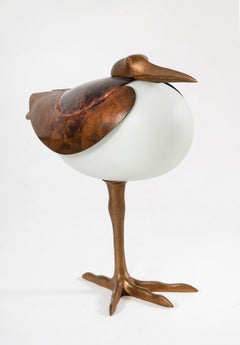Lalanne Bird Lamp
Recent Sales
1990s Modern Figurative Sculptures
Bronze, Copper
François-Xavier Lalanne for sale on 1stDibs
François-Xavier Lalanne was born in 1927 in Agen. After the war, he moved to Paris where he studied at the Académie Julian to become a painter. On the occasion of his first exhibition at the Cimaise Gallery in Paris in 1952, Lalanne met Claude Dupeux (Lalanne), his future wife. After meeting her, he gave up painting and started working with her.
The first joint exhibition for Claude and François-Xavier, titled "Zoophite," took place in 1964 at the J. Gallery. They revealed their creations — hybrids of sculptures and everyday objects. In 1966, they introduced themselves under the name Les Lalanne.
The two artists each created their own works but shared a common universe inspired by the animal and plant world and often exhibited together.
François-Xavier invented a bestiary composed of monkeys, rhinos, donkeys, camels, toads, hippos and cats. Among them, the sheep was undoubtedly his favorite animal. Alone or in a flock, with or without a head, sheathed in the fleece of sheep or not, his sheep sculptures can also constitute seats. His will, shared by Claude, was to desacralize the sculpture to give it a familiar dimension.
François-Xavier is also known for his public commissions. For example, in France he created two concrete pigeons in the city of Grande-Borne in Grigny, and Les Pleureuses (“The Mourners”) is a monumental fountain created in 1986 by François-Xavier and Claude that was installed at the Hakone Open-Air Museum in Japan.
In 1968, François-Xavier was made a Knight of Arts and Letters. His works have been acquired by great collectors such as Yves Saint Laurent and Pierre Bergé, the Rothschilds and Charles and Marie-Laure de Noailles. The work of Les Lalanne is exhibited throughout the world, presented in both galleries and museums. The retrospective organized in 2010 by the Musée des Arts Décoratifs is one of the last major exhibitions of the duo. After a long career, François-Xavier died in 2008 in Ury.
Find authentic François-Xavier Lalanne sculptures, prints and other art and furniture on 1stDibs.
(Biography provided by Bailly Gallery Geneva-Paris)
A Close Look at Modern Art
The first decades of the 20th century were a period of artistic upheaval, with modern art movements including Cubism, Surrealism, Futurism and Dadaism questioning centuries of traditional views of what art should be. Using abstraction, experimental forms and interdisciplinary techniques, painters, sculptors, photographers, printmakers and performance artists all pushed the boundaries of creative expression.
Major exhibitions, like the 1913 Armory Show in New York City — also known as the “International Exhibition of Modern Art,” in which works like the radically angular Nude Descending a Staircase by Marcel Duchamp caused a sensation — challenged the perspective of viewers and critics and heralded the arrival of modern art in the United States. But the movement’s revolutionary spirit took shape in the 19th century.
The Industrial Revolution, which ushered in new technology and cultural conditions across the world, transformed art from something mostly commissioned by the wealthy or the church to work that responded to personal experiences. The Impressionist style emerged in 1860s France with artists like Claude Monet, Paul Cézanne and Edgar Degas quickly painting works that captured moments of light and urban life. Around the same time in England, the Pre-Raphaelites, like Edward Burne-Jones and Dante Gabriel Rossetti, borrowed from late medieval and early Renaissance art to imbue their art with symbolism and modern ideas of beauty.
Emerging from this disruption of the artistic status quo, modern art went further in rejecting conventions and embracing innovation. The bold legacy of leading modern artists Georges Braque, Pablo Picasso, Frida Kahlo, Salvador Dalí, Henri Matisse, Joan Miró, Marc Chagall, Piet Mondrian and many others continues to inform visual culture today.
Find a collection of modern paintings, sculptures, prints and other fine art on 1stDibs.
